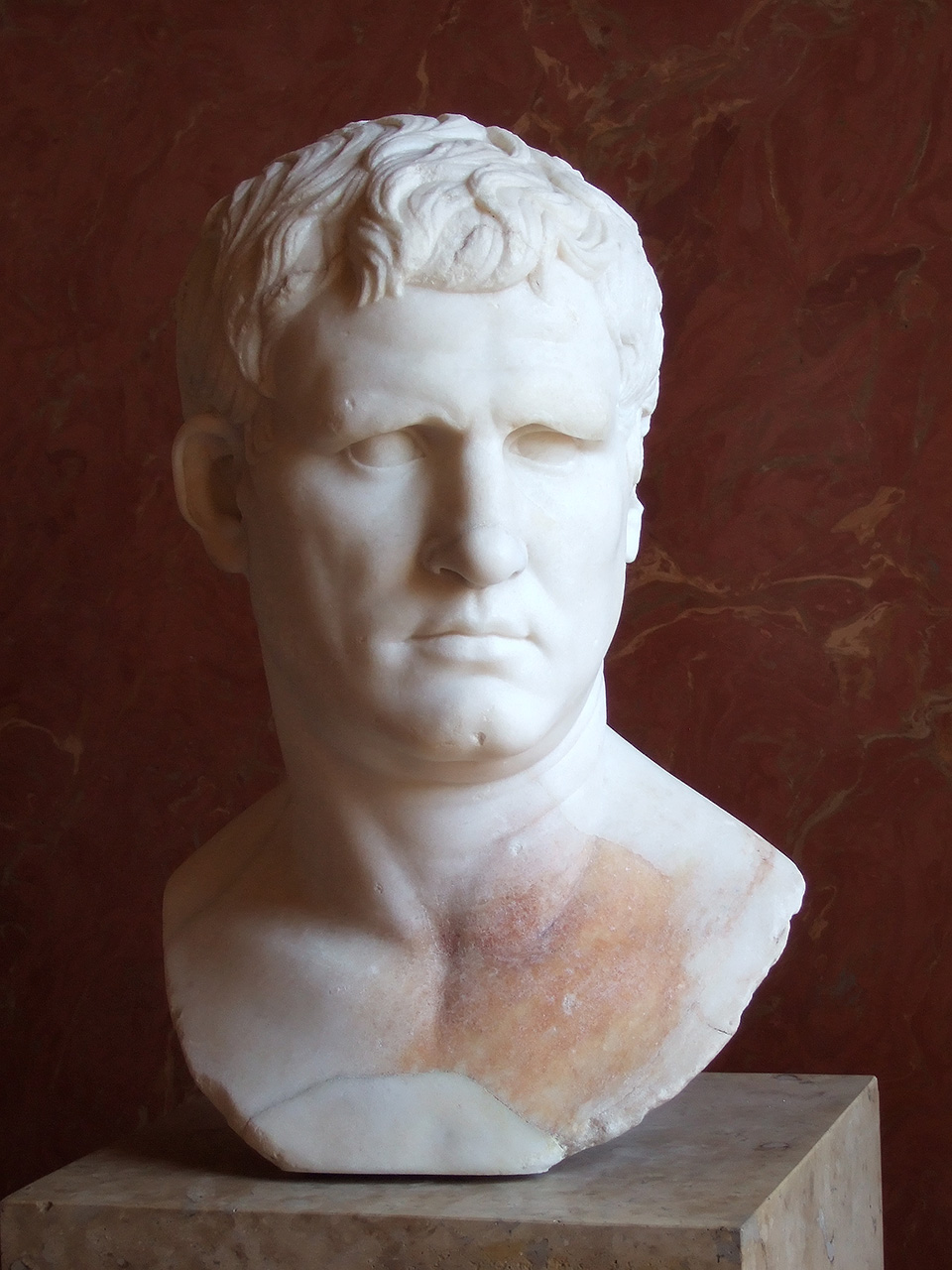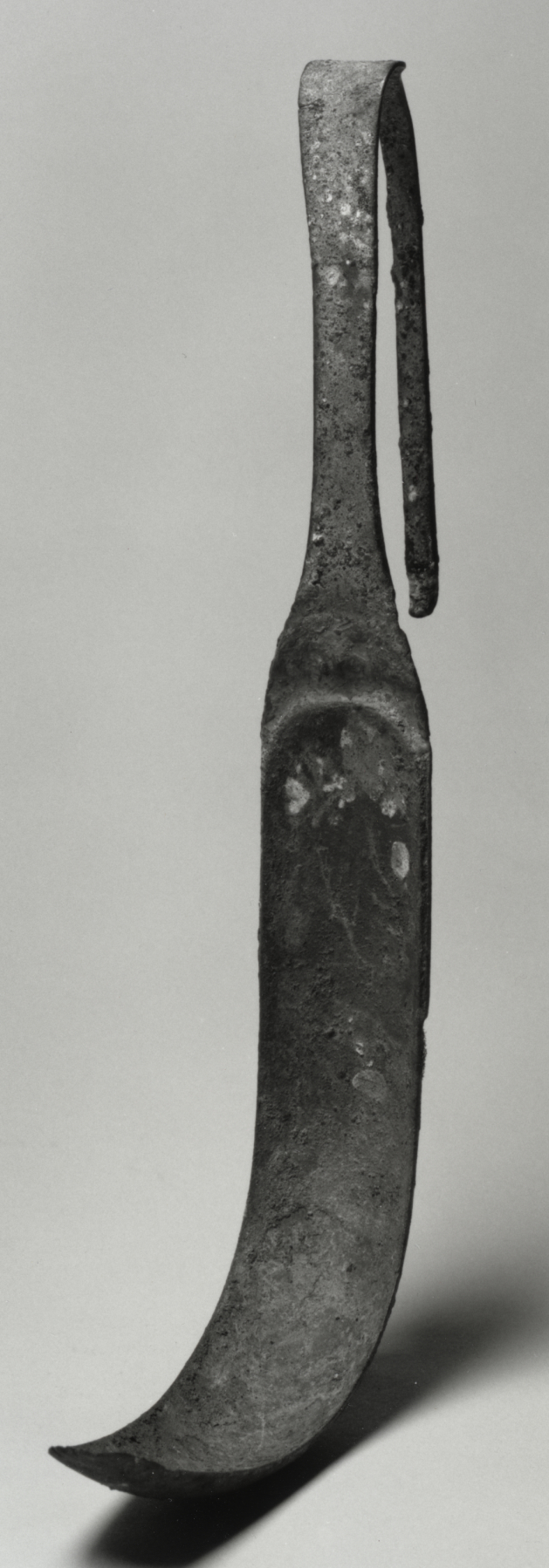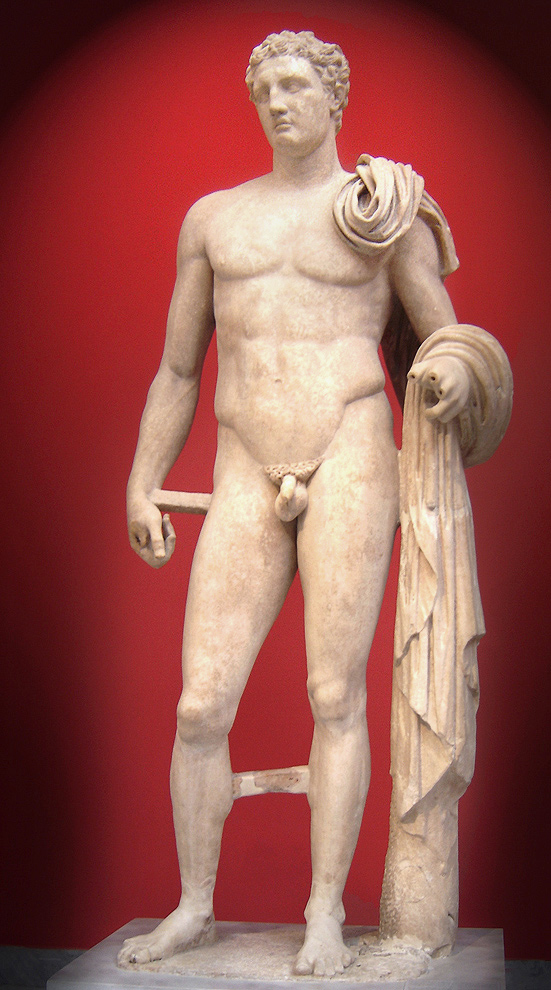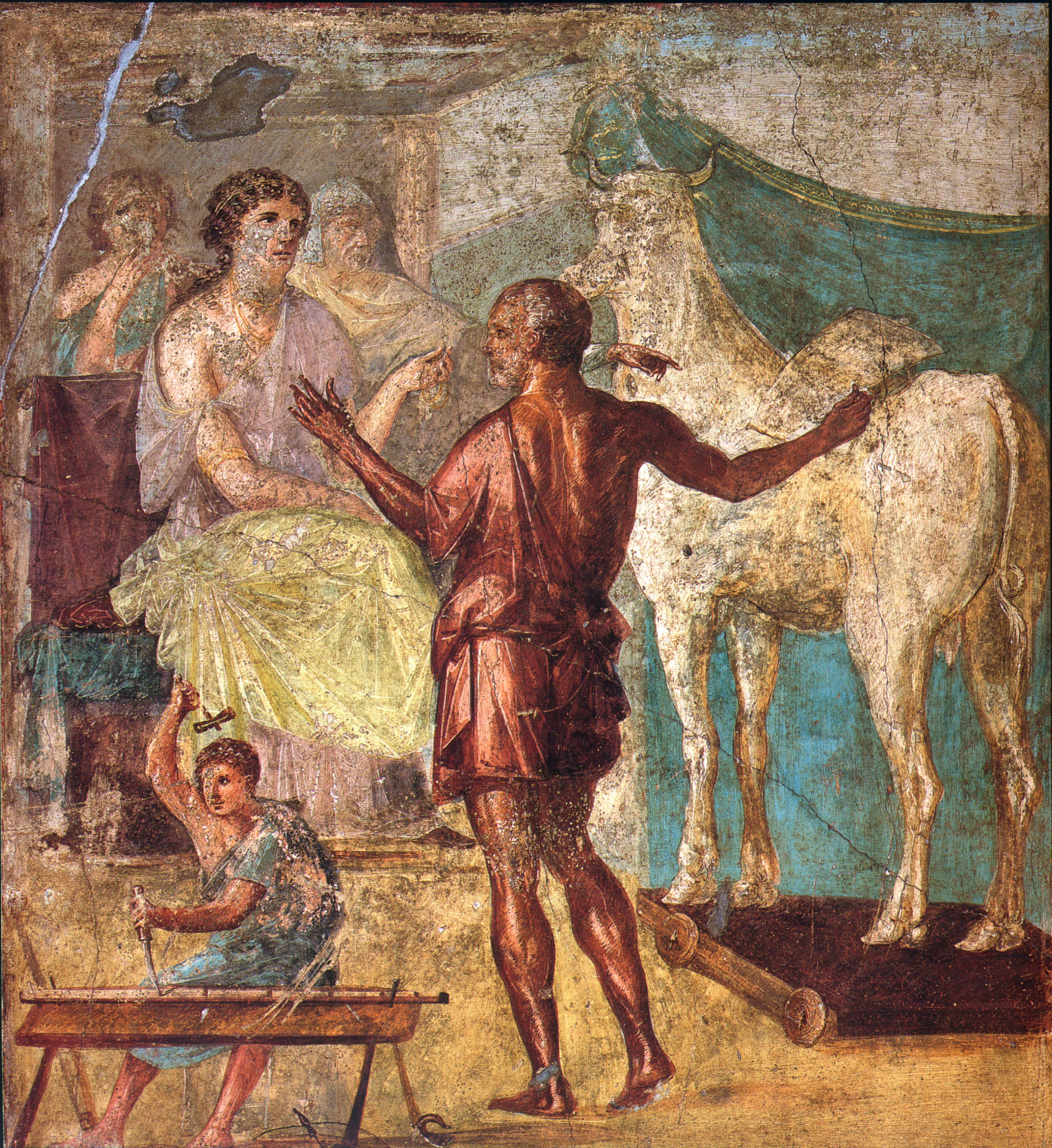|
Apoxyomenos
Apoxyomenos (plural apoxyomenoi: the "Scraper") is one of the conventional subjects of ancient Greek votive sculpture; it represents an athlete, caught in the familiar act of scraping sweat and dust from his body with the small curved instrument that the Greeks called a stlengis and the Romans a strigil. The most renowned ''Apoxyomenos'' in Classical Antiquity was that of Lysippos of Sikyon, the court sculptor of Alexander the Great, made ca 330 BCE. The bronze original is lost, but it is known from its description in Pliny the Elder's '' Natural History'', which relates that the Roman general Marcus Vipsanius Agrippa installed Lysippos's masterpiece in the Baths of Agrippa that he erected in Rome, around 20 BCE. Later, the emperor Tiberius became so enamored of the figure that he had it removed to his bedroom. However, an uproar in the theatre, "Give us back our Apoxyomenos", shamed the emperor into replacing it. The sculpture is commonly represented by the Pentelic marble c ... [...More Info...] [...Related Items...] OR: [Wikipedia] [Google] [Baidu] |
Baths Of Agrippa
The Baths of Agrippa (Latin: Thermae Agrippae) was a structure of ancient Rome, in what is now Italy, built by Marcus Vipsanius Agrippa. It was the first of the great thermae constructed in the city, and also the first public bath. History In the bath's first form, completed in 25 BC, it was a hot-air room also known as a "laconian sudatorium or gymnasium". With the completion of the Aqua Virgo in 19 BC, the baths were supplied with water and with the addition of a large lake and canal ('' Stagnum Agrippae'').(LacusCurtius website) Samuel Ball Platner, ''A Topographical Dictionary of Ancient Rome'' (London: Oxford University Press) 1929. See also note by William ... [...More Info...] [...Related Items...] OR: [Wikipedia] [Google] [Baidu] |
Strigil
The strigil ( el, στλεγγίς, translit=stlengis, probably a loanword from Pre-Greek substrate) is a tool for the cleansing of the body by scraping off dirt, perspiration, and oil that was applied before bathing in Ancient Greek and Roman cultures. In these cultures the strigil was primarily used by men, specifically male athletes; however, in Etruscan culture there is some evidence of strigils being used by both sexes. The standard design is a curved blade with a handle, all of which is made of metal. Strigils were commonly used by individuals who were engaging in vigorous activities, in which they accumulated large amounts of dirt and sweat on their bodies. The people who used the strigil included athletes, the wealthy, soldiers, and more. However, wealthy or prestigious individuals often had slaves to wield the strigils and clean their bodies, rather than doing it themselves. Strigils were not only significant in a practical sense, but culturally as well. They are oft ... [...More Info...] [...Related Items...] OR: [Wikipedia] [Google] [Baidu] |
Lysippos
Lysippos (; grc-gre, Λύσιππος) was a Greek sculptor of the 4th century BC. Together with Scopas and Praxiteles, he is considered one of the three greatest sculptors of the Classical Greek era, bringing transition into the Hellenistic period. Problems confront the study of Lysippos because of the difficulty of identifying his style among the copies which survive. Not only did he have a large workshop and many disciples in his immediate circle, but there is understood to have been a market for replicas of his work, supplied from outside his circle, both in his lifetime and later in the Hellenistic and Roman periods. The '' Victorious Youth'' or Getty bronze, which resurfaced around 1972, has been associated with him. Biography Born at Sicyon around 390 BC, Lysippos was a worker in bronze in his youth. He taught himself the art of sculpture, later becoming head of the school of Argos and Sicyon. According to Pliny, he produced more than 1,500 works, all of them in b ... [...More Info...] [...Related Items...] OR: [Wikipedia] [Google] [Baidu] |
Polykleitos
Polykleitos ( grc, Πολύκλειτος) was an ancient Greek sculptor in bronze of the 5th century BCE. Alongside the Athenian sculptors Pheidias, Myron and Praxiteles, he is considered one of the most important sculptors of classical antiquity. The 4th century BCE catalogue attributed to Xenocrates (the "Xenocratic catalogue"), which was Pliny's guide in matters of art, ranked him between Pheidias and Myron. He is particularly known for his lost treatise (a canon of body proportions), the ''Canon of Polykleitos'', setting out his mathematical basis of an idealised male body shape. None of his original sculptures are known to survive, but there are many of what are believed to be later copies in marble, mostly Roman. Name His Greek name was traditionally Latinized ''Polycletus'', but is also transliterated ''Polycleitus'' ( grc, Πολύκλειτος, Classical Greek , "much-renowned") and, due to iotacism in the transition from Ancient to Modern Greek, ''Poly ... [...More Info...] [...Related Items...] OR: [Wikipedia] [Google] [Baidu] |
Marble
Marble is a metamorphic rock composed of recrystallized carbonate minerals, most commonly calcite or dolomite. Marble is typically not foliated (layered), although there are exceptions. In geology, the term ''marble'' refers to metamorphosed limestone, but its use in stonemasonry more broadly encompasses unmetamorphosed limestone. Marble is commonly used for sculpture and as a building material. Etymology The word "marble" derives from the Ancient Greek (), from (), "crystalline rock, shining stone", perhaps from the verb (), "to flash, sparkle, gleam"; R. S. P. Beekes has suggested that a " Pre-Greek origin is probable". This stem is also the ancestor of the English word "marmoreal," meaning "marble-like." While the English term "marble" resembles the French , most other European languages (with words like "marmoreal") more closely resemble the original Ancient Greek. Physical origins Marble is a rock resulting from metamorphism of sedimentary carbonate ro ... [...More Info...] [...Related Items...] OR: [Wikipedia] [Google] [Baidu] |
Vatican Museums
The Vatican Museums ( it, Musei Vaticani; la, Musea Vaticana) are the public museums of the Vatican City. They display works from the immense collection amassed by the Catholic Church and the papacy throughout the centuries, including several of the most well-known Roman sculptures and most important masterpieces of Renaissance art in the world. The museums contain roughly 70,000 works, of which 20,000 are on display, and currently employ 640 people who work in 40 different administrative, scholarly, and restoration departments. Pope Julius II founded the museums in the early 16th century. The Sistine Chapel, with its ceiling and altar wall decorated by Michelangelo, and the Stanze di Raffaello (decorated by Raphael) are on the visitor route through the Vatican Museums. In 2020, due to the COVID-19 pandemic, the Vatican Museums were visited by only 1,300,000 persons, a drop of 81 percent from the number of visitors in 2019, but still enough to rank the museums fourth among th ... [...More Info...] [...Related Items...] OR: [Wikipedia] [Google] [Baidu] |
Trastevere
Trastevere () is the 13th ''rione'' of Rome: it is identified by the initials R. XIII and it is located within Municipio I. Its name comes from Latin ''trans Tiberim'', literally 'beyond the Tiber'. Its coat of arms depicts a golden head of a lion on a red background, the meaning of which is uncertain. History In Rome's Regal period (753–509 BC), the area across the Tiber belonged to the Etruscans: the Romans named it ''Ripa Etrusca'' (Etruscan bank). Rome conquered it to gain control of and access to the river from both banks, but was not interested in building on that side of the river. In fact, the only connection between Trastevere and the rest of the city was a small wooden bridge called the '' Pons Sublicius'' (English: 'bridge on wooden piles'). By the time of the Republic c. 509 BC, the number of sailors and fishermen making a living from the river had increased, and many had taken up residence in Trastevere. Immigrants from the East also settled there, mainly Jew ... [...More Info...] [...Related Items...] OR: [Wikipedia] [Google] [Baidu] |
Plaster Cast
A plaster cast is a copy made in plaster of another 3-dimensional form. The original from which the cast is taken may be a sculpture, building, a face, a pregnant belly, a fossil or other remains such as fresh or fossilised footprints – particularly in palaeontology (a track of dinosaur footprints made in this way can be seen outside the Oxford University Museum of Natural History). Sometimes a blank block of plaster itself was carved to produce mock-ups or first drafts of sculptures (usually relief sculptures) that would ultimately be sculpted in stone, by measuring exactly from the cast, for example by using a pointing machine. These are still described as plaster casts. Examples of these by John Flaxman may be found in the central rotunda of the library at University College London, and elsewhere in the University's collections. It may also describe a finished original sculpture made out of plaster, though these are rarer. Method Plaster is applied to the origin ... [...More Info...] [...Related Items...] OR: [Wikipedia] [Google] [Baidu] |
Daidalos Of Sicyon
In Greek mythology, Daedalus (, ; Greek: Δαίδαλος; Latin: ''Daedalus''; Etruscan: ''Taitale'') was a skillful architect and craftsman, seen as a symbol of wisdom, knowledge and power. He is the father of Icarus, the uncle of Perdix, and possibly also the father of Iapyx. Among his most famous creations are the wooden cow for Pasiphaë, the Labyrinth for King Minos of Crete which imprisoned the Minotaur, and wings that he and his son Icarus used to escape Crete. It was during this escape that Icarus did not heed his father's warnings and flew too close to the sun; the wax holding his wings together melted and Icarus fell to his death. Epigraphic evidence The name ''Daidalos'' appears to be attested in Linear B, a writing system used to record Mycenaean Greek. The name appears in the form ''da-da-re-jo-de'', possibly referring to a sanctuary. Family Daedalus's parentage was supplied as a later addition, with various authors attributing different parents to him. His fath ... [...More Info...] [...Related Items...] OR: [Wikipedia] [Google] [Baidu] |
Contrapposto
''Contrapposto'' () is an Italian term that means "counterpoise". It is used in the visual arts to describe a human figure standing with most of its weight on one foot, so that its shoulders and arms twist off-axis from the hips and legs in the axial plane. First appearing in Ancient Greece in the early 5th century BCE, contrapposto is considered a crucial development in the history of Ancient Greek art (and, by extension, Western art), as it marks the first time in Western art that the human body is used to express a psychological disposition. The style was further developed and popularized by sculptors in the Hellenistic and Imperial Roman periods, fell out of use in the Middle Ages, and was later revived during the Renaissance. Michelangelo's statue of ''David'', one of the most iconic sculptures in the world, is a famous example of contrapposto. Definition Contrapposto was historically an important sculptural development, for its appearance marks the first time in Western ... [...More Info...] [...Related Items...] OR: [Wikipedia] [Google] [Baidu] |
Aphrodite Of Knidos
The Aphrodite of Knidos (or Cnidus) was an Ancient Greek sculpture of the goddess Aphrodite created by Praxiteles of Athens around the 4th century BC. It is one of the first life-sized representations of the nude female form in Greek history, displaying an alternative idea to male heroic nudity. Praxiteles' Aphrodite is shown nude, reaching for a bath towel while covering her pubis, which, in turn leaves her breasts exposed. Up until this point, Greek sculpture had been dominated by male nude figures. The original Greek sculpture is no longer in existence; however, many Roman copies survive of this influential work of art. Variants of the ''Venus Pudica'' (suggesting an action to cover the breasts) are the Venus de' Medici and the Capitoline Venus. Original The ''Aphrodite of Knidos'' was commissioned as the cult statue for the Temple of Aphrodite at Knidos. It depicted the goddess Aphrodite as she prepared for the ritual bath that restored her purity, discarding her drapery w ... [...More Info...] [...Related Items...] OR: [Wikipedia] [Google] [Baidu] |






_of_the_Pinacoteca_Vaticana.jpg)


